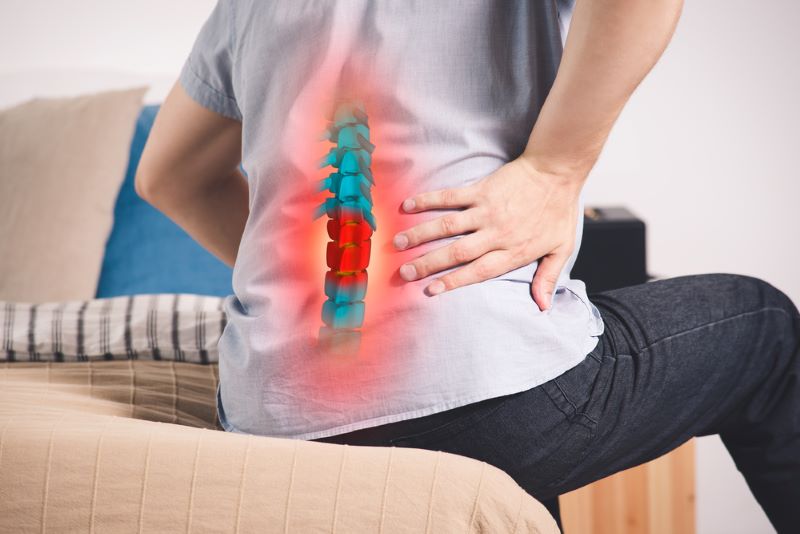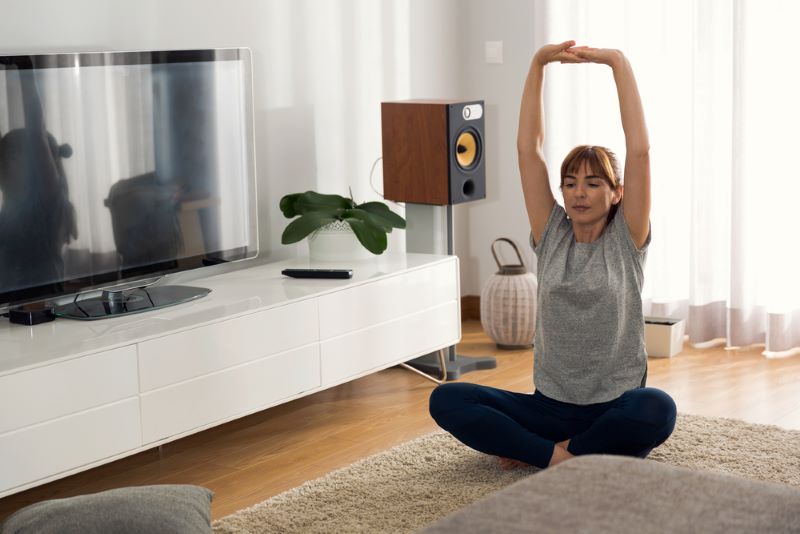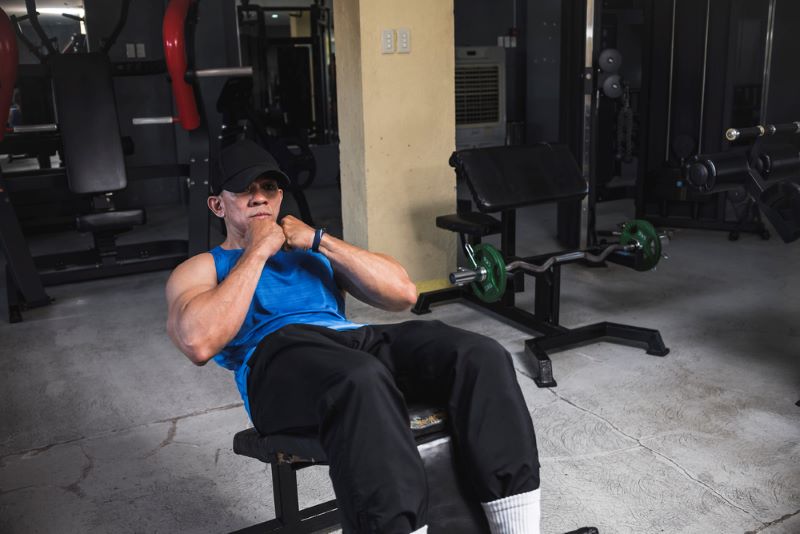Sit-ups are a great exercise for developing your core muscles, your core strength, your posture, and your overall muscle definition. The exercise itself is pretty simple, comes with a relatively low level of risk, and is highly adaptable too.
However, for all the good things that exercises like sit-ups bring to the table, there are always some negative points to think about.
Sit-ups are no exception to this so there are some important things to keep in mind when it comes to performing the exercise safely and effectively.
Whether you currently do sit-ups as part of your training program or whether you’re looking to add them to your workouts as a new addition, a common question that seems to come up about sit-ups is whether they’re bad for your back or not.
This can be a particularly important thing to consider if you already have back issues or an existing injury that needs to be kept in mind when adding new exercises to your training plan.
So, in this article, we discuss whether sit-ups are bad for your back or not.
We talk about why you might get back pain during and after sit-ups, how you can avoid getting back pain as a result of doing sit-ups in the first place, as well as looking at various variations of sit-ups that might be better or worse for your back.

Are Sit-Ups Bad For Your Back?
Sit-ups aren’t necessarily bad for your back but they can cause some back issues if you aren’t careful.
Your lower back, in particular, is at an increased risk of pain, discomfort, and potential injury if you do a large number of sit-ups on a regular basis.
The biggest factor that leads to this increased risk is that you have to bend your lumbar spine forward when doing sit-ups correctly.
While your spine is designed to deal with some level of bending, flexing, and other movements, the forward bending required for sit-ups puts a lot of pressure on your lumbar discs.
This increased pressure can eventually wear down the discs in your lumbar spine which can then lead to quite a bit of pain and discomfort.
If you do sit-ups correctly, the chances of you damaging your back are relatively small.
However, you should be aware that sit-ups can potentially cause back issues. With that in mind, it seems fair to say that while sit-ups might not directly injure your back, they can be bad for your back in the long term due to the wear and tear they create in your lumbar spine.
Why Do You Get Back Pain During Sit-Ups?
Weak Core
Back pain during sit-ups can be a sign that your core is weak and doesn’t have the strength to deal with the stress being placed on it during sit-ups.
Although sit-ups are designed to strengthen your core, if you try to do too many too soon, your weak core muscles may struggle.
If your muscles are struggling during an exercise, muscle strains can quite easily happen resulting in a painful injury to deal with.
Your lower back is actually part of your core muscles. This is something that some people forget so don’t associate lower back pain with a weak core. Instead, they believe they need to strengthen their back.
As they do more and more back exercises to make their back stronger, they probably aren’t hitting their lower back as they need to so when it comes to doing sit-ups again, the lower back pain is still present due to weakness in your core (including your lower back).
Poor Or Incorrect Technique
Although sit-ups are a pretty simple exercise to do, there are still plenty of points where you can get things wrong.
One of the key ways that people go wrong with sit-ups is by hyperextending their spine.
This is basically where your hips lift up off the floor causing a curve in your spine.
There are obviously other errors you can make in your sit-up technique, but hyperextension is certainly one that can cause back pain during sit-ups.
Tight Muscles
If you have any tightness or stiffness in the working muscles, you could very well experience pain in your back while you do sit-ups.
Even if the tight muscles aren’t in your back, having a lack of flexibility and mobility in any area of your body can move the stress caused by the exercise onto more vulnerable and weaker parts of your body.
Before doing sit-ups, it’s usually a good idea to do a thorough warm up including some stretches to help properly prepare your muscles for the exercise they are about to undertake.
Why Do You Get Back Pain After Sit-Ups?
Poor Or Incorrect Technique
Like during sit-ups, if your technique is incorrect or not quite right, you could experience back pain after sit-ups.
Even seemingly minor errors in technique can lead to sit-ups causing back pain.
Your back is placed in a fairly vulnerable position during sit-ups, so if you’re making mistakes in your technique, the level of vulnerability increases further which also increases the risk of injury, pain, and discomfort.
Back Injury

If you’re feeling pain in your back after sit-ups, it might be an indication that you’ve a back injury that needs looking at.
While doing sit-ups might not have actually caused the injury in the first place, it could be that the movement involved in the exercise is making the injury worse or aggravating the injured part of your body.
Anything more than mild discomfort being felt in your back should be taken seriously and getting the advice of a medical professionall might be your best course of action.
Normal Post Exercise Muscle Soreness
Sit-ups work your core muscles. Any muscles that are worked during exercise are likely to have some level of discomfort and soreness afterward as they have to repair the microscopic tears that formed in them during the exercise.
As your lower back forms part of your core muscles, it could be that any pain or soreness felt in your lower back is perfectly normal and should be expected after sit-ups.
That being said, it’s always worth keeping in mind that the soreness felt in your back after sit-ups should be mild and not prevent you from doing all the things you need to do in your day-to-day life.
Anything more than mild discomfort might be something more, but low levels of soreness in your back after sit-ups could simply be a sign that you are working your muscles as hard as you need to in order to develop and grow.
How To Avoid Back Pain During Sit-Ups
Make Sure Your Technique Is Correct
One of the best ways of avoiding back pain during sit-ups is to make sure that your technique is 100% correct.
Any errors regardless of how big (or small), can lead to a much bigger impact than you might expect.
By making sure your technique is completely correct, you stand a good chance of keeping back pain at bay during sit-ups.
Properly Prepare Your Body

A thorough and proper warmup is important before any exercise.
Before doing sit-ups, you should do your best to do a warmup that includes flexibility and mobility movements for your back (and other areas of your body that will be working).
If your body is properly prepared for the exercise you want it to do, the risk of pain and injury tends to be lower.
Gradually Increase The Intensity
As with any exercise, you should always try to build up the intensity of sit-ups gradually.
If you do too many sit-ups too soon, the risk of something going wrong and pain being felt, particularly in your back, increases quite drastically.
Take your time, build your muscular strength and endurance gradually and sit-ups will be much more unlikely to hurt your back.
Can Sit-Ups Cause A Back Injury?
As safe as sit-ups tend to be, there are points where your back is placed under quite a lot of stress which can lead to an injury if you aren’t careful.
Unless your technique is incorrect, sit-ups, on their own, aren’t likely to cause a back injury. However, if you get things wrong, a back injury could be a possibility when doing sit-ups.
Are Decline Sit-Ups Bad For Your Back?

Maybe, but it depends on your technique and your medical history.
Decline sit-ups can put additional stress on your lower back which isn’t a good thing.
If you have back issues, decline sit-ups might not be your best choice of exercise.
Are Incline Sit-Ups Bad For Your Back?
Like decline sit-ups, incline sit-ups can increase your risk of injury slightly.
It’s really important that you only do this variation of sit-ups if you have the appropriate levels of fitness and strength to do it correctly and safely.
Are GHD Sit-Ups Bad For Your Back?
Glute-ham developers (GHD sit-ups) are only really suitable for highly experienced gym-goers who have very high levels of muscular strength, endurance, and overall fitness.
Your body has to do some very complex movements to make the exercise happen so it can be bad for your back if you have anything other than complete back health and fitness.
Are Weighted Sit-Ups Bad For Your Back?
When you add extra resistance to your sit-ups (by adding a weight), the amount of stress placed on the working muscles (and your back) increases quite substantially.
While weighted sit-ups aren’t necessarily bad for your back, they’ll certainly place more stress and pressure on your back so this is something you’ll need to keep in mind.
Are Straight Leg Sit-Ups Bad For Your Back?
Straight leg sit-ups are known for putting excessive stress on your lower back.
If you’re worried about injuring your back or if you want to keep the chances of experiencing back pain after sit-ups as low as possible, it might be best to avoid this sit-up variation.
Conclusion
In summary, sit-ups aren’t bad for your back but they can cause lower back pain if you do them incorrectly.
That’s all for this article, but do sit-ups make you poop? Or does sit-ups increase testosterone?
Hope this helped!
Sources
https://aaptiv.com/magazine/lower-back-pain-workouts
I’ve been in the fitness and strength training industry for nearly a decade. In that time, I’ve gained 30 pounds of muscle, written hundreds of articles, and reviewed dozens of fitness supplements. As for my educational background, I’m a currently studying for my Active IQ Level 3 Diploma in Personal Training.

